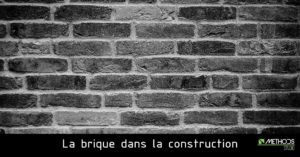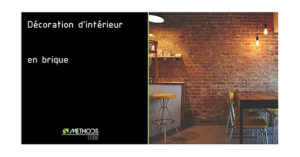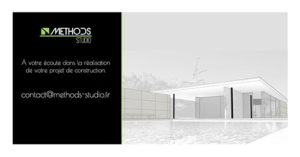 From Toulouse to London, from Madagascar to the Ivory Coast - we find brick in constructions all over the planet.
From Toulouse to London, from Madagascar to the Ivory Coast - we find brick in constructions all over the planet.
Although we tend to think of bricks as being “old”, they have actually made great strides to become a modern building material. Cinder blocks are just one example. Your architect and building firm, Methods Studio Architects, takes a look at this ancient and yet so modern material.
Which brick should you choose when building?
Why build a house from bricks?
Brick is an ecological material, with good sanitary and insulating qualities, resistant and durable. Different types of building bricks exist,
The advantages of building construction brick are:
- Efficient insulation: brick provides natural insulation, so you can enjoy even more comfort in your home

- Clay bricks are environmentally-friendly: this is a natural material, so production generates very little pollution.
- A healthy and breathable material this is a hygienic material with which to build your home.
- Stylish: the building brick is at once classic and modern. Bring your design ideas to life with brick! timeless and modern. Bring your design ideas to life with brick!
The terracotta brick, being a natural material, fits perfectly into current logics eco-construction, the environmentally friendly construction.
The disadvantages of brick are mainly in the cost. Indeed, brick construction requires less widespread know-how and therefore less inexpensive than concrete block construction.
Bricks come in a range of colors from gray to red – it all depends on what color clay was used to make them.
What are the various types of bricks?
There are a variety of bricks:
- The most common is the clay brick
- The plastic brick, more suitable for installing interior partitions
- plastic brick, more suitable for installing interior partitions
- The foam brick, inexpensive and light, it has good insulating properties but is susceptible to thermal bridges if there are any manufacturing flaws
The clay brick is the one most used in construction today. It is a natural material made from clay, water, and sometimes certain additives. It is the color of the clay that gives the brick its color, such as gray or red.
There are several types :
- Solid bricks often left exposed or used as cladding for a concrete wall or chimney column
- Cored bricks, the hollows of which may be horizontal or vertical. These are thicker and make it possible to mount sturdy walls that provide good insulation.
- The Monomur and Biomur bricks lighter and more insulating. It's here "modern" version of wall bricks that we find in our big Parisian cities.
- Bricks that can be used with mortar glue, reducing the amount of mortar and cement needed and quicker to put up. Their energy efficiency is better as joints, and therefore thermal bridges, are reduced.
- Refractory bricks, or firebricks, are used specifically where the bricks need to be able to withstand great heat, such as in fireplaces, ovens, and barbecues etc.
- Frost-resistant bricks designed for cold climates, withstand very low temperatures.
Which brick for my construction?
The choice of the type of brick for your construction will depend on several factors:
- Your budget: solid bricks are cheaper to buy than hollow bricks but take longer to put up, especially in traditional building works. The global cost depends on the desired wall thickness. Do not hesitate to contact us for more information.
- Your choice of insulation: brick insulation, or interior or exterior insulation?
- Your style choices: a solid brick wall is beautiful
- Architectural constraints: load-bearing wall / partition
The different types of brick insulation recommended by our architect and building firm
When building with bricks, you can choose from several insulation options:
- Distributed thermal insulation: which consists of using self-insulating bricks. They have rock fiber insulation in the hollows, thus combining the effectiveness of monowall bricks and better technical performance.
- Exterior thermal insulation: combining monowall bricks with an insulating cladding against the outside off the wall. It is the most efficient solution after distributed thermal insulation. However, it alters the exterior appearance of the house, and increases its floor space coefficient. You may need to consult local planning regulations to make sure you are not in breach.
- Interior thermal insulation: This is the cheapest of the three isolation options. We combine monowall bricks with indoor insulation. The house or apartment is insulated from cold walls and humidity. Your home will then be more comfortable and energy-efficient but you will lose some surface inside.
Whatever your renovation or building budget, and the work to be carried out, seek support or ask for advice from experts in construction or home insulation. Contact us.
Bricks for building your house
A short history of the brick
 Brick is a very old material, it is dated to almost -8000 years BC It was created on the need to protect oneself from the elements and predators with a
Brick is a very old material, it is dated to almost -8000 years BC It was created on the need to protect oneself from the elements and predators with a
hard and resistant material. In some regions, this need has been met with natural stone or wood. But in some areas, Man had to use what he had at his fingertips: clay. By letting it dry in the sun the Mesopotamians were thus able to create the first artificial stones and build resistant buildings.
The material was then perfected to spread in Ancient Rome, then in Northern Europe with Gothic brick architecture.
In France, Toulouse became an important center of brick production, and is nicknamed the Pink City.
The post-war era sees brick gradually replaced by concrete and steel (because the rehousing needs were important and the reinforced concrete is the optimal solution for the construction of buildings of more than 10 floors). It was at the end of the 20th century that brick will come back in force, thanks to its energy and environmental qualities.
Brick as a design feature
Brick is a building material base, but you can also use it to include it as a as a decorative element.For a "New Yorker" style, use red brick in conjunction with steel, and create your "Little Brooklyn" at home. A red brick bar between the kitchen and the living room, black painted steel beams, some industrial furniture, and you are transported to the other side of the Atlantic! Red brick lends itself perfectly to a beautiful lighting. His irregular appearance is highlighted by points of light such as fairy lights or several well-placed lights.
For a more rustic style, leave the brick exposed on one of the interior walls of your home. A brick wall goes perfectly with white walls and brings warmth to the room. To add a country touch, use the brick to make a vault over a door!
Bricks can work very well with light woods, especially if you paint the brick wall in white for example.
Do you have a garden or yard? Why not build a magnificent brick barbecue for your summer evenings? Or even a traditional pizza oven? On an outdoor space, a brick wall can be easily painted, in white or in color, to give an original and “street art” touch to your exterior.
As you will have realized, brick is a resolutely modern and very versatile material, both in construction and in layout and decoration. When used for building, brick is a high-performance material with real ecological advantages. Whatever your budget or project, think about brick! If you need help in your choices and in keeping your overall budget down, our team of experts will assist you. Contact us.
Find out more about bricks
- The history of brick
https://fr.wikipedia.org/wiki/Brique_(matériau)
- utting up a brick wall with glue (wall bricks)
https://www.youtube.com/watch?v=_b0D30_pzPA
- Building a refractory brick barbecue
https://www.youtube.com/watch?v=_sRhS93EIF0
- Brick walls: how to enhance your interior?
https://www.for-interieur.fr/mur-en-brique-deco/

Subscribe to our LinkedIn page to discover all our articles
The Methods Studio team
Only when you are satisfied is our job done
https://www.methods-studio.fr
Contact our architect-builders: contact@methods-studio.fr



